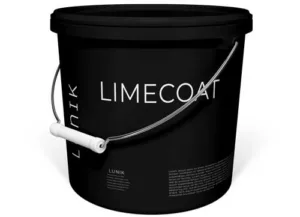LIMECOAT

LIME BASE COATING
CLAYCOAT lime-based coating with acrylic resins and aggregates is an innovative option to protect and beautify surfaces both indoors and outdoors. The combination of traditional lime with acrylic resins provides excellent adhesion, flexibility and durability, while the aggregates add texture and mechanical resistance.
This siding offers a natural and rustic appearance, with the versatility to adapt to various architectural styles. Plus, it’s breathable, weather-resistant, and easy to maintain, making it a sustainable, low-maintenance option for residential and commercial projects.
High mechanical and chemical resistance
Good workability
Breathable
Suitable for indoors and outdoors
CLAYCOAT S
CLAYCOAT M
CLAYCOAT L
Where can
be installed?
Interior
Exterior
Kitchen
Wet Room
Lime-Based Mortar: A Historical Link to Construction
Since time immemorial, lime-based mortar has been an essential component in construction, with a history dating back to ancient civilizations such as the Romans and the Egyptians. This material has stood the test of time, maintaining its relevance in contemporary architecture due to its countless advantages and uses.
History and Evolution:
Lime, a material obtained by cooking limestone, has been used since ancient times as a binder in construction. The ancient Romans were pioneers in its application, using it in the production of mortars for the construction of emblematic buildings such as the Colosseum and the Pantheon. This legacy spread throughout Europe, where lime mortar became the standard for cladding, plastering and masonry.
Advantages of Lime-Based Mortar:
- Flexibility and Breathability: Lime allows structures to breathe, preventing the accumulation of moisture and the proliferation of mold and fungi. This makes it an ideal option for the restoration of historic buildings and sustainable construction.
- Durable Adhesion: Lime offers excellent adhesion to a variety of substrates, promoting the stability and durability of structures.
- Fire Resistance: Lime mortar is highly fire resistant, making it suitable for applications in fire-prone areas.
- Aesthetic Versatility: With a wide range of shades and textures, lime mortar allows for aesthetic customization, from rough and rustic finishes to smooth and elegant surfaces.
- Sustainability: Lime production is less energy intensive than other binders such as Portland cement, making it a greener and more sustainable option.
Uses of Lime-Based Mortar:
Coatings: Lime mortar is commonly used to coat walls both indoors and outdoors, providing a durable and aesthetically attractive finish.
Restoration and Conservation: It is especially valuable in the restoration of historic buildings and monuments, where authenticity and structural integrity are sought to be maintained.
Landscaping: Used in the construction of retaining walls and raised gardens, providing a durable and aesthetically pleasing solution.
Architectural Finishes: From fireplaces to arches and columns, lime mortar is used to create a variety of architectural elements with a distinctive look and exceptional durability.
In short, lime-based mortar not only has a rich history in construction, but also remains a relevant and versatile option in contemporary architecture, offering a unique combination of durability, aesthetics and sustainability.